Cosmology is a branch of astronomy dedicated to examining the characteristics and development of the entire Universe. This discipline draws upon mathematics, physics, and astronomy to establish its foundation.
The Evolution of Cosmology
In its early stages, cosmology consisted of religious myths that explored the origins (cosmogony) and ultimate fate (eschatology) of the world as we know it.
China
According to archaeological discoveries, there is evidence to propose that the original form of the universe could have been represented by the outer shell of a terrestrial tortoise, which was divided into squares, thus creating the plane of the earth.
One of the earliest representations of Chinese cosmology suggests that the Earth was thought to be covered by the sky, resembling a canopy on a chariot. This canopy would rotate horizontally, much like an umbrella. This model, known as the Zhoubi model, was described in a mathematical treatise called Zhoubi. However, during the Han dynasty, this model began to be challenged by astronomical observations. A new model, called the huntian model, emerged, proposing that the space surrounding the Earth was spherical. Around 180 CE, Cai Yong mentioned a third model called xuanye, but no further information about it has survived to this day.
Antiquity in Europe
The majority of ancient Greek astronomers embraced the geocentric model of the universe, which posits that the Earth is a stationary, spherical body with five planets, the Sun, and the Moon revolving around it. Despite the proposal put forth by Aristarchus of Samos for a heliocentric model, it seems that most ancient Greek scholars did not rally behind this theory.
The sphere of fixed stars [1] was once considered to be the limit of the world. Some also believed in an additional sphere that was responsible for precession. According to Aristotle and his followers, known as the Peripatetics, there was nothing beyond the world – no matter or space. On the other hand, the Stoics believed in the existence of infinite empty space. The atomists, including Leucippus, Democritus, Metrodorus, Epicurus, and Lucretius, believed in the existence of other worlds beyond our own. They saw the universe as infinite. Heraclides of Pontus had a unique perspective, considering the stars to be distant worlds that included earth and air. Both the atomists and Heraclides believed in the infinity of the universe. Towards the end of antiquity, a religious and mystical doctrine called Hermeticism emerged, suggesting that there could be an area outside the world inhabited by immaterial beings – spirits [2].
The Medieval Era
During the Medieval Era, the field of astronomy and philosophy in Christian and Muslim societies was largely influenced by Aristotle’s cosmology. This was further supplemented by the Ptolemaic theory of planetary motion, as well as the concept of celestial spheres made of material substances. Some philosophers during the 13th and 14th centuries speculated that God, who possessed infinite power, could have created other worlds apart from our own [3]. However, this idea remained purely hypothetical, as it was believed that although God had the ability to create other worlds, He chose not to do so. Certain philosophers, such as Thomas Bradwardine and Nicholas Orem, proposed the existence of an infinite space beyond our world, which served as the dwelling place of God. This view was a modification of the cosmology of the Hermeticists, who also believed that the space beyond our world belonged to the spiritual realm [4].
The Renaissance Era
The cosmology presented by Nicholas of Cusa in his treatise “On Scholarly Ignorance” is characterized by its innovative nature. He proposed the idea of the material unity of the universe, considering the Earth as one of many planets that are in motion. According to Cusa, the celestial bodies, like our Earth, are inhabited, and any observer in the universe can consider themselves motionless. He believed that the universe is both infinite and finite, with infinity being a characteristic solely attributed to God. Cusa also incorporated elements of medieval cosmology, such as the existence of celestial spheres, including the outer sphere of fixed stars. However, these spheres are not perfectly round, their rotation is not uniform, and their axes of rotation do not have a fixed position in space. Consequently, the universe lacks an absolute center and a clear boundary, indicating its boundlessness.
The emergence of a new heliocentric world system by Nicolaus Copernicus in the first half of the 16th century is a significant development. Copernicus revolutionized the understanding of the universe by placing the Sun at the center, with the planets, including Earth, revolving around it. He also proposed the idea of Earth’s rotation around its axis. Despite these groundbreaking ideas, Copernicus still maintained the belief in the existence of celestial spheres and a bounded universe, as indicated by his inclusion of a sphere of fixed stars [6].
Giordano Bruno’s Universe (illustration from Kepler’s book A Summary of Copernican Astronomy, 1618). Symbolized by M marks our world.
The concept of an infinite and uniformly filled Universe was pioneered by the Italian philosopher Giordano Bruno. Bruno proposed that the Universe would appear similar from any vantage point, suggesting that stars are distant suns and that the laws of physics apply universally throughout boundless space [8]. This idea of an infinite Universe was also supported by William Hilbert in the late 16th century and later by René Descartes, Otto von Guericke, and Christian Huygens during the 17th century.
The rise of modern cosmology
The rise of modern cosmology can be traced back to the advancements in Einstein’s general theory of relativity (GTR) and elementary particle physics during the 20th century. In 1917, Einstein published his groundbreaking work titled “Cosmological Considerations to the General Theory of Relativity,” which laid the foundation for this field. In this study, he put forth three fundamental assumptions: the universe is uniform, isotropic, and static. To account for the static nature, Einstein introduced a “cosmological term” into the gravitational field equations. The resulting solution implied that the Universe has a finite volume (closed) and a positive curvature.
In 1922, A. A. Friedman put forward an innovative solution to the Einstein equation, suggesting that the Universe was not stationary but instead expanding from a singularity at its inception. The groundbreaking discovery of the cosmological redshift of galaxies by E. Hubble in 1929 provided compelling evidence in support of Friedman’s theory, ultimately leading to the widespread acceptance of the Big Bang theory.
Related Articles
Important Points
- ↑ Furley 1981.
- ↑ Gatti 1999, p. 103.
- ↑ McColley 1936; Grant 1994.
- ↑ Grant 1969 explores the impact of Hermetic literature on Bradwardine.
- ↑ Coire 2001, pp. 2-17 and particularly p. 14.
- ↑ Barker 1990.
- ↑ Coire 2001; Gatti 1999, pp. 105-106; Granada 2008.
- ↑ Koire 2001, pp. 31-45.
- Bakina V. I. The cosmological teachings of Heraclitus of Ephesus // Bulletin of Moscow University. Ser.7. Philosophy. 1998.№ 4. P.42-55.
- Bakina V. I. Cosmological teachings of early Greek philosophers: Textbook. M., Publishing house of Moscow University. 1999. -104 p.
- Weinberg S. The First Three Minutes: A Modern View of the Origin of the Universe. – Izhevsk: SIC “Regular and Chaotic Dynamics”, 2000, 272 pp. ISBN 5-93972-013-7
- Gavryushin N. K. Byzantine Cosmology in the 11th century // Historical and Astronomical Studies. – Moscow: “Nauka”, 1983. Issue XVI. P.325-338.
- Gavryushin N. K. Cosmological treatise of the 15th century as a monument of Old Russian natural science // Monuments of Science and Technology. 1981. M.: Nauka, 1981, P. 183-197.
- Loren GrahamChapter XII Cosmology and Cosmogony from the book Natural Science, Philosophy, and the Sciences of Human Behavior in the Soviet Union.
- Zhitomirsky S. V. Heliocentric Hypothesis of Aristarchus of Samos and Ancient Cosmology // Historical and Astronomical Studies. М., 1986. Vyp. 18. С. 151-160.
- Idlis G. M. Revolutions in Astronomy, Physics and Cosmology. M., 1985.-232 p.
- Koire A. From a Closed World to an Infinite Universe: Translated from English. Series: Sigma. 2001.
- Cosmological Works in the Scribes of Ancient Russia. Part II: Texts of the Planar-Comarian and Other Cosmological Traditions" // Series "Monuments of Old Russian Thought". Vol. IV(2) / Ed. by V. V. Milkov, S. S. S. Kovalev. V. Milkov, S. M. Polyansky. St. Petersburg: Publishing House "Mir", 2008 (640 p.). (50B7 a.l.).
- Lebedev A. V. Thales and Xenophanes (The Ancient Fixation of Thales’ Cosmology) // Antique Philosophy in the Interpretation of Bourgeois Philosophers. Moscow, 1981.
- Lupandin I. V. Aristotelian cosmology and Thomas Aquinas // Questions of the history of science and technology. 1989. No. 2. P.64-73.
- Makeev V. A. Ancient Philosophical Cosmography in the Modern Culture of Eastern Countries. -Moscow: RUDN, 1993
- Mochalova I. N. About two cosmological traditions in the Early Academy // Bulletin of the Leningrad State University named after A. S. Pushkin (series of philosophy). 2007.- No. 3 (6).- P.26-34.
- Nagirner D. I. Elements of Cosmology. – St. Petersburg: SPbSU Publishing House, 2001.
- Pavlenko A. N. Modern cosmology: the problem of justification // Astronomy and scientific picture of the world. M. IFRAN, 1996;
- Pavlenko A. N. European cosmology: the foundations of the epistemological shift, M.- INTRADA, 1997;
- Sazhin M. V. Contemporary cosmology in a popular presentation. URSS. 2002. 240 p.
- Semushkin A. V. Speculative Cult of Cosmos in Early Greek Philosophy // Religion in the Changing World. – Moscow: Izd-vo RUDN, 1994. – pp.27-39.
- Tursunov A. Philosophy and Modern Cosmology. M., 1977.
- M. L. Filchenkov, S. V. Kopylov, V. S. Evdokimov Course of General Physics: Additional Chapters.
- Frolov B. Number in Archaic Cosmology // Astronomy of Ancient Societies. M., 2002. pp.61-68.
- Chernin A. D. Stars and Physics. 2nd ed. URSS. 2004. 176 p.
- P. Barker, Copernicus, the orbs, and the equant, Pierre Duhem : historian and philosopher of science I, Synthese 83 (2) (1990), 317-323. 01A40.
- C. Bonneau and S. Brunier. A space and time-defying probe. Science&Vie, № 1072, January 2007, p. 43
- David J. Furley, The Greek Theory of the Boundless Universe, Journal of the History of Ideas, Vol. 42, No. 4 (Oct. — Dec., 1981), pp. 571–585.
- Gatti H. Giordano Bruno and the Science of the Renaissance, Cornell Univercity Press, 1999.
- Gombrich, R. F. «Ancient Indian Cosmology.» In Ancient Cosmologies, edited by Carmen Blacker and Michael Loewe, 110—142. London: Allen and Unwin, 1975.
- Granada, Miguel A. Kepler and Bruno on the Boundlessness of the Universe and Solar Systems, Journal for the History of Astronomy, Vol. 39, No. 4, p. 469—495
- Grant E., «Medieval and Seventeenth-Century Conceptions of an Infinite Void Space Beyond the Cosmos.» Isis, vol. 60, part 1, no. 201 (1969), 39-60.
- Grant E., Planets, Stars, and Orbs: The Medieval Cosmos, 1200—1687, Cambridge: Cambridge Univ. Pr., 1994.
- Henderson, John B. The Development and Decline of Chinese Cosmology. Neo-Confucian Studies Series. New York: Columbia University Press, 1984.–>
- McColley G., The seventeenth-century doctrine of a plurality of worlds, Annals of Science 1, 1936, pp. 385-430.
- Sircar D.S. Cosmography and Cosmology in Early Indian Literature. Calcutta, 1976 (1st ed.: Calcutta,1967).
- Timeline of cosmology: http://en.wikipedia.org/wiki/Timeline_of_cosmology
References
- A website dedicated to contemporary cosmology. Archived from the original source on August 22, 2011.
- Cosmology. Archived from the original source on August 25, 2011.
- Ned Wright’s Tutorial on Cosmology. Archived from the original source on August 25, 2011.
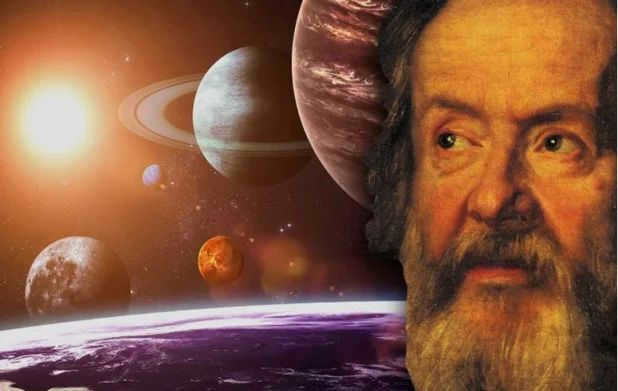
Throughout the ages, individuals have held a deep fascination with inquiries regarding the genesis of our cosmos. Numerous enigmas within the realm of outer space remain unresolved. The field of science dedicated to the study of celestial entities continues to advance, with esteemed astronomers guiding our exploration of the marvels that encircle our planet within the boundless reaches of the universe.

In today’s rapidly changing world, simply relying on the knowledge provided in the standard school curriculum is no longer sufficient. It is crucial to also gain a practical understanding of finance and investments in order to secure your financial stability.
Take control of your future by expanding your knowledge and skills in financial literacy through our online FINANCIAL LITERACY program.

Register now, APPLY FOR YOUR SUCCESS
Hipparchus of Nicea (190 – 120 BC)
One of the pioneers of astronomy was the ancient Greek astronomer Hipparchus, who resided and operated in Rhodes. Among the accomplishments of the scientist, it is worth highlighting that he implemented geographical coordinates, categorized the positions of stars visible to the naked eye, and computed the apparent movements of the Sun and Moon. Hipparchus attributed the initial stellar magnitude to the most luminous stars and the sixth magnitude to the dimmest ones.
By utilizing trigonometry and utilizing ancient Babylonian records for astronomical computations and carefully observing planetary motion, Hipparchus of Nicaea concluded that the Earth was stationary and that all planets revolve around it. Through his calculations of the sizes of the Sun and Moon and their distances from Earth, he compiled a comprehensive catalog of lunar eclipses in Babylon from the 8th century B.C. to the middle of the 3rd century B.C. Additionally, by comparing his own observations with those of previous astronomers, he was able to accurately determine the length of the solar year.
Hipparchus was responsible for transforming astronomy into a predictive science. He was the first to observe and document the phenomenon of the precession of the equinoxes. Additionally, Hipparchus introduced the revolutionary hexadecimal system.

Claudius Ptolemy (c. 90 -168).
The ancient Greek scientist Claudius Ptolemy made a significant contribution to the field of astronomy. His scientific works earned him widespread recognition and acclaim. Ptolemy’s theory on the structure of the universe, as detailed in his treatise “The Great Work,” was widely accepted as truth during the Middle Ages. In his work known as the Almagest, Ptolemy provided a rationale for the geocentric model of the universe. According to the astronomer, the Earth is positioned at the center of the universe, with celestial bodies such as stars, the moon, and the sun revolving around it. These celestial bodies move in a uniform manner, following the paths of epicycles. In other words, a planet traces a circular path around a point that is itself in motion. And if that point moves in a circular path around the Earth, it is referred to as a deferent.
The scientist developed a method that allowed for the calculation of the precise location of any planet at a specific moment in time. With remarkable accuracy, he determined the distance between the Earth and the Sun as well as the Moon, creating a comprehensive catalog of the night sky that includes 48 constellations.
Claudius authored the book “Phases of Fixed Stars,” which outlines techniques for weather prediction and provides insights into the arrangement of celestial bodies.
Claudius Ptolemy’s lifelong fascination with the universe led him to develop the “astrolabon,” a combination of armillary spheres, for observing the stars. Additionally, his invention of the “triquetrum” served as the precursor to the wall circle.
He wrote the book “Handy Tables”, which is similar to an astronomy guide. It contains tables that can be used to calculate the precise position of planets and other astronomical events at a specific time.
However, Claudius Ptolemy did not only focus on astronomy. He also made notable contributions to mathematical cartography and geography.

Nicolaus Copernicus (1473 – 1543)
Nicolaus Copernicus, born on February 19, 1473, was a renowned astronomer and mathematician from Poland. He is best known for his heliocentric theory, which proposed that the Sun is the center of the universe, and that the Earth and other planets revolve around it. This theory revolutionized the field of astronomy and challenged the prevailing geocentric model, which placed the Earth at the center of the universe.
Copernicus’s groundbreaking work, “De Revolutionibus Orbium Coelestium” (On the Revolutions of the Celestial Spheres), was published in 1543, just before his death. In this book, he presented his heliocentric theory and provided evidence to support it. Copernicus’s ideas were met with resistance from the scientific community and the Catholic Church, as they contradicted the prevailing beliefs of the time. However, his theories laid the foundation for the scientific revolution and paved the way for future discoveries in astronomy.
Copernicus’s contributions to the field of astronomy are widely recognized and celebrated. His heliocentric theory marked a significant shift in our understanding of the universe and laid the groundwork for the modern scientific approach. Today, he is considered one of the most important figures in the history of science.
Nicolaus Copernicus, the renowned Polish astronomer, was the first to introduce the concept of a heliocentric model of the universe, sparking a groundbreaking scientific revolution. Through meticulous mathematical calculations, Copernicus demonstrated that the Earth orbits around the Sun, completing a full revolution in its orbit within a year. Prior to this revolutionary discovery, the prevailing belief was in a geocentric model of the universe. Copernicus detailed his groundbreaking system in his extensive scientific work, “On the Rotations of the Celestial Spheres,” a project that spanned over four decades. Throughout this time, he continuously refined and recalculated his theories. Unfortunately, Copernicus only caught a glimpse of the printed version of his book before his passing. At one point, the Inquisition deemed his work heretical and prohibited its dissemination, a ban that lasted until 1833. However, despite this setback, Copernicus’s scientific contributions brought him worldwide acclaim, and his theories laid the foundation for the works of future luminaries such as Kepler and Newton. Today, Copernicus is universally recognized and honored, with various celestial bodies, including a star, craters, a minor planet, and even a chemical element, bearing his name.
Aside from conducting astronomical research, scientist Nicolaus Copernicus was involved in various other projects and activities. He contributed to the construction of a hydraulic machine and played a role in the establishment of the Polish mint. Additionally, Copernicus demonstrated his artistic talent and worked as a doctor, providing free medical care to those in need. Furthermore, the scientist is credited with formulating the concept of universal gravitation.
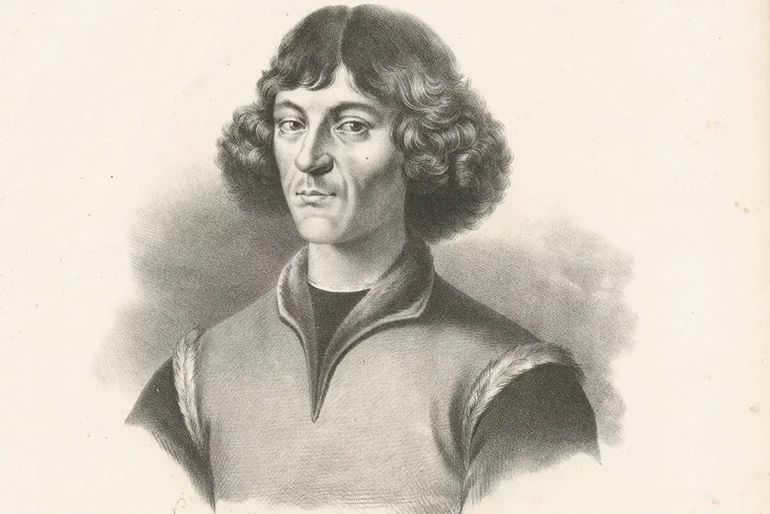

Tycho Brahe (1546 – 1601)
Tycho Brahe, a renowned Danish astronomer, is credited with the discovery of a supernova star that appeared in the constellation of Cassiopeia and caught the attention of the scientific community. This event took place in November 1572, as Tycho Brahe was making his way back home from the laboratory. It marked the first supernova eruption in 500 years. For a period of 17 months, Tycho Brahe meticulously observed and studied the object until it eventually vanished. The findings were later compiled and published in his book “Essays on New Astronomy” in 1602.
Astronomer Tycho Brahe independently constructed the inaugural observatory, which he christened “Uraniborg”. The king provided funds for its construction, but Tycho Brahe himself also contributed a significant amount and never regretted it. Soon, “Uraniborg” evolved into the premier hub of astronomy, seamlessly combining observations, scientific publication, and the training of future astronomers. Multiple observatories were erected, and it was in one of these that Tycho Brahe made his initial breakthroughs in 1572.
The astronomer dedicated extensive time to his work, but his greatest passion lay in observing the heavens. Thus, his creation, the “sextant”, enabled him to conduct observations in a novel and more effective manner.
Every endeavor undertaken by Tycho Brahe during his lifetime ultimately paved the way for I. Kepler to discover the laws of planetary motion many years later.

Galileo Galilei (1564-1642)
Galileo Galilei, an Italian scientist, gained renown for his groundbreaking discoveries that revolutionized our understanding of the world. His use of the telescope played a pivotal role in these achievements. Inspired by the innovative work of a Dutch craftsman who had invented the telescope using lenses from spectacles, Galileo Galilei was inspired to create his own version.
While gazing at the planets, the astronomer caught sight of a curvature, a blemish on the illuminated portion of the Moon, indicating the ruggedness of its surface. The shifting blemishes on the Sun offered Galileo Galilei the chance to argue for its rotation on its axis. While observing Venus, the scientist observed the presence of the same phases as the Moon. Galileo Galilei’s breakthroughs also encompassed: Jupiter’s moons, Saturn’s ring, observations of the Milky Way, which led the astronomer to realize that most of the nebulous markings consist of stars.
Astronomy was not the sole field of study that captivated the scientist. He was drawn to philosophy, mathematics, physics, mechanics, where he made numerous scientific discoveries as well.
The life tale of Galileo Galilei was brimming with captivating occurrences, as he was a brilliant intellect and an exceptional scientist. Despite the fact that some of his breakthroughs were not acknowledged by the church during his time, this in no way diminishes his contributions to the field of science.
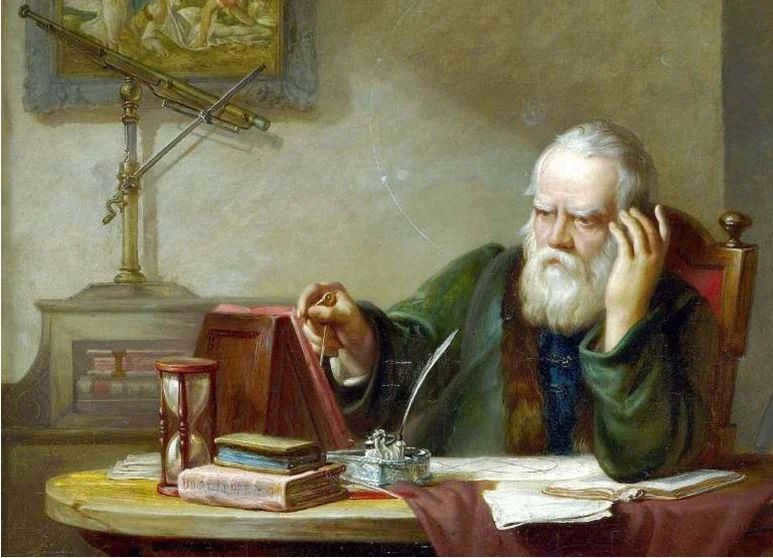

Johannes Kepler (1571 – 1630)
Einstein referred to the German scientist Johannes Kepler as “a man without equal”. Kepler made significant contributions to the field of astronomy. He is credited with the discovery of three laws that explain the movement of planets in the solar system. Kepler concluded that the Sun exerts a powerful influence on the planets, causing them to move in elliptical orbits. As a result, he determined that planets closer to the Sun move faster due to the increasing acceleration force as they approach it.
In October 1604, a fresh star emerged in the sky, prompting the scientist Johannes Kepler to conduct a thorough observation of it. Kepler held the belief that the tides were a result of the Moon’s gravitational pull, and that the Sun required its own axis to revolve around it.
Astronomy held great significance in Johannes Kepler’s life. The publication of the astronomical tables, known as “Rudolph’s”, in the summer of 1627, garnered immense popularity and saw extensive use by sailors and astronomers well into the 19th century.
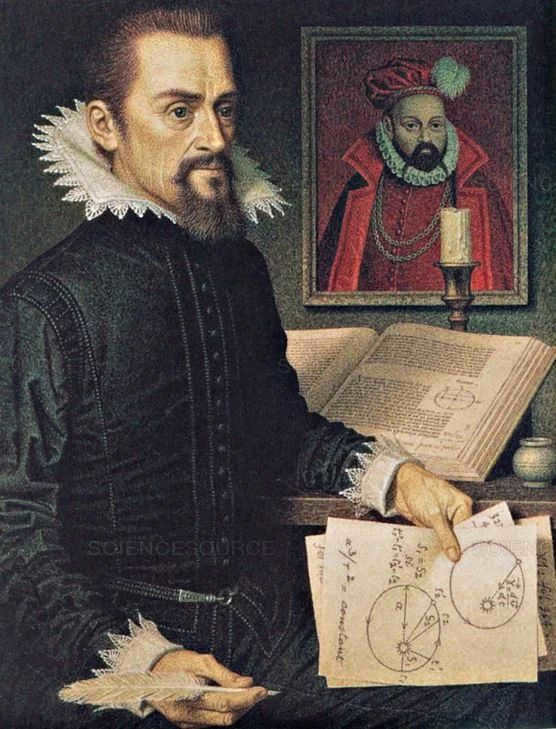
Edmund Halley (1656 – 1742)
Edmund Halley, an English astronomer, made an important breakthrough in the field of astronomy when he discovered the proper motion of the stars. He dedicated a significant amount of time studying comets, which completely revolutionized the scientific community’s understanding of these celestial objects. Prior to Halley’s research, it was believed that comets originated from outer space and simply passed through the solar system before disappearing into the void.
Through his meticulous research, Halley was able to prove that most comets are actually the same celestial bodies and that the comet he observed in 1682 had an elliptical orbit. He calculated that this comet would return to Earth every 75-76 years. According to his predictions, it was due to reappear in 1758. Unfortunately, Halley did not live to witness this event. In honor of his groundbreaking work, the comet he discovered was named after him – Halley’s Comet.
Edmund Halley made numerous significant discoveries in the field of astronomy. One of his notable achievements was uncovering the inequalities of Jupiter and Saturn. Additionally, Halley played a crucial role in determining the astronomical unit, which is used to measure the distance between the Sun and the Earth. These accomplishments solidify his position as a prominent figure in the field of astronomy.
Another noteworthy contribution by Halley was his catalog of stars, which consisted of 341 objects located in the southern hemisphere. This impressive work led to him being recognized as a Fellow of the Royal Society of London.
Later in life, at the age of 63, Halley developed a keen interest in lunar observations. Despite dedicating 18 years of continuous effort to this pursuit, he was unable to complete his research. Unfortunately, the esteemed astronomer passed away at the age of 85.
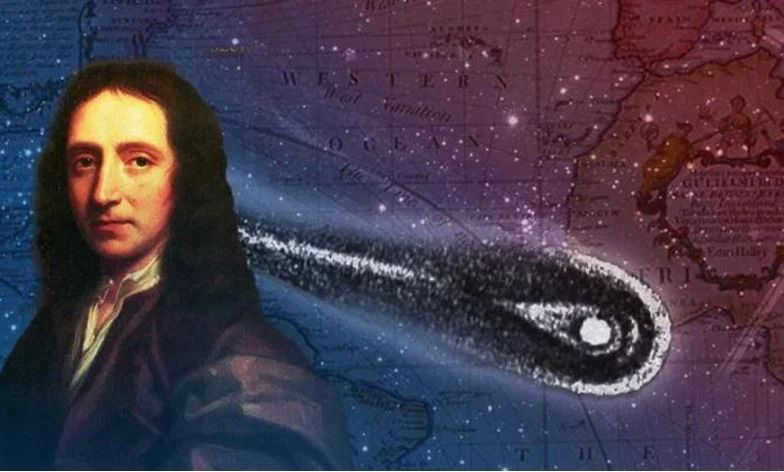

William Herschel: The Pioneer of Stellar Astronomy
William Herschel, the renowned English scientist, is widely recognized as the founder of stellar astronomy. Together with his son John, he made significant discoveries in the field, particularly in the identification of numerous nebulae. Concurrently, they conducted extensive research on comets, leading to their comprehensive description and the creation of catalogs. Notably, Herschel received valuable support from his sister Caroline, who was also a prominent astronomer.
While observing the night sky through his telescope, William Herschel made an intriguing discovery. He noticed a radiant object that was absent from the star map. Intrigued, he diligently tracked the object’s movements and determined that it was traversing among the stars. On March 13, 1781, Herschel officially named this newfound planet Uranus, making it the seventh planet in our Solar System. Additionally, Herschel was the first to discuss the existence of stellar systems, providing evidence through his study of double and multiple stars.
Due to limited financial resources, Herschel was unable to purchase a telescope and instead took on the challenge of constructing his own instruments, both for personal use and for sale. Fortunately, the English king eventually stepped in to offer financial support. With the generous funding from George III, Herschel embarked on the construction of an observatory under his guidance.
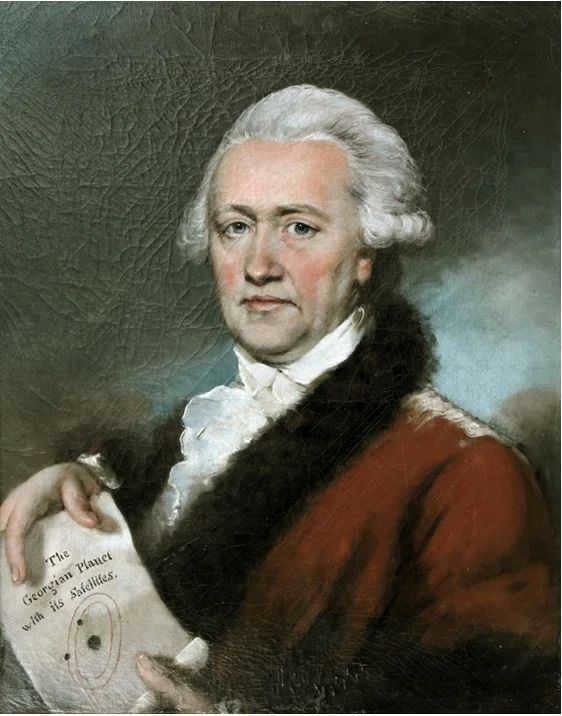
Pierre-Simon Laplace (1749 – 1827)
Pierre-Simon Laplace, born on March 23, 1749, was a French mathematician and astronomer. He is considered one of the greatest scientists of his time and made significant contributions to the fields of mathematics, physics, and astronomy.
Laplace is best known for his work in celestial mechanics, where he developed mathematical models to explain the motions of the planets and other celestial bodies. His mathematical equations, known as Laplace’s equations, are still used today in the field of physics.
Aside from his contributions to celestial mechanics, Laplace also made important discoveries in probability theory and statistics. He introduced the concept of statistical independence and developed the Laplace distribution, a probability distribution widely used in statistics.
Laplace was a prolific writer and published numerous books and papers throughout his career. His most famous work is “Traité de mécanique céleste” (Treatise on Celestial Mechanics), a five-volume book that laid the foundation for modern celestial mechanics.
Throughout his life, Laplace received numerous honors and awards for his contributions to science. He was a member of several prestigious scientific societies, including the French Academy of Sciences and the Royal Society of London. He also served as the Minister of the Interior under Napoleon Bonaparte.
Pierre-Simon Laplace died on March 5, 1827, at the age of 77. His contributions to science and mathematics continue to be recognized and celebrated to this day.
Pierre-Simon Laplace is a renowned scientist who gained fame for his discoveries and research in various fields of scientific endeavor. He has made significant contributions in mathematics, physics, and mechanics. Currently, there exists Laplace’s theorem, as well as Laplace’s law and function in physics. Moreover, his contributions to astronomy are remarkable. He is credited with proposing the existence of galaxies other than the Milky Way. Laplace applied Newton’s theory of gravity to the solar system and elucidated the mutual influence of planets that leads to their approach and separation from the Sun. He also provided a scientific explanation for the acceleration of the Moon and its dependence on average speed. Additionally, Laplace hypothesized the presence of black holes in outer space and proposed a rotating gas model for the solar system. He also devised a novel method for determining the orbits of celestial bodies. Another noteworthy contribution attributed to Laplace is the theory of tides.
Pierre-Simon Laplace’s groundbreaking masterpiece “Celestial Mechanics” brought about a revolution in the field and provided astronomers with numerous solutions to their inquiries. In recognition of his remarkable discoveries and contributions, Laplace was bestowed with prestigious titles such as Marquis, the Grand Cross, the Legion of Honor, and the Order of Reunion. His enduring legacy is commemorated by having his name immortalized on the iconic Eiffel Tower, as well as through the dedication of streets, an asteroid, and a crater in his honor.
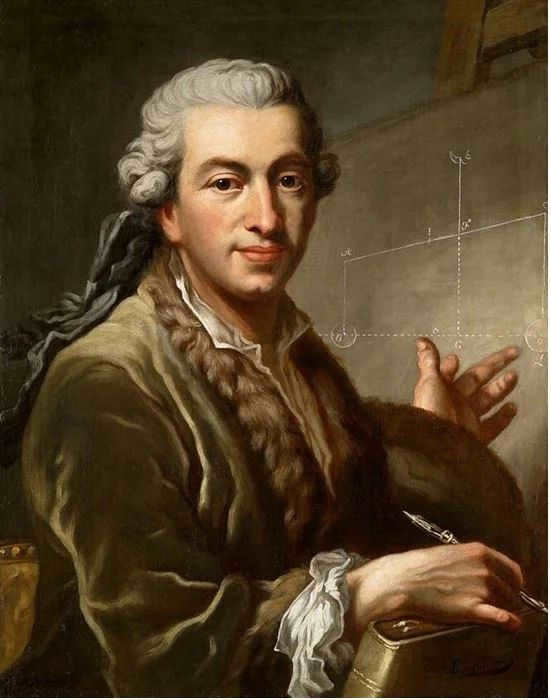
Edwin Hubble: A Pioneer in the Study of Space
Edwin Hubble, a globally recognized American astronomer, dedicated a significant portion of his life to the exploration of outer space. His groundbreaking discoveries revolutionized the scientific understanding of the universe. Hubble’s extensive research on galaxies unveiled the existence of celestial bodies beyond the Milky Way, displaying nebulae situated at considerable distances from our own galaxy. These findings directly indicated the presence of other cosmic formations. Additionally, Hubble formulated a fundamental law, now bearing his name, which demonstrated through physical and mathematical principles that our universe is continuously expanding in all directions. This law also supports the Big Bang theory, explaining the origin of the Universe. Hubble’s contributions extended beyond his law, as he is also honored through an asteroid, a telescope, and a sequence named after him. In 1925, Hubble devised a morphological system for classifying galactic formations based on their visual appearance. His research revealed that galaxies possess not only a spiral shape but also an elliptical shape. This classification system remains in use by scientists to this day. In 1935, Hubble even discovered an asteroid, named 1373 Cincinnati. While Hubble’s remarkable work would have undoubtedly merited a Nobel Prize if astronomical research had been eligible during his lifetime, such recognition was not possible posthumously. Nevertheless, his exceptional contributions to the field were duly acknowledged, as he received accolades such as the Bernard Medal, the gold medal of Katherine Wolf Bruce, and the gold medal of the Royal Astronomical Society throughout his career.
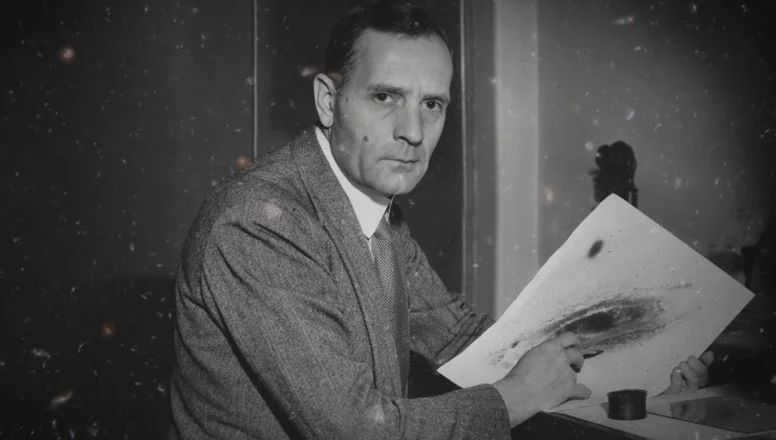
The names of these renowned astronomers have made an indelible mark in history and will forever be etched in our collective memory. Each of these remarkable individuals has left an enduring legacy through their groundbreaking research and astounding discoveries, enriching our understanding of the vast cosmos. Their invaluable contributions continue to shape the scientific community, propelling the advancement of knowledge and exploration in the realm of outer space.

Currently, there are extra cumulative discounts (ranging from 2% to 25%) that are accessible to 58.741 educational establishments. To determine which discount applies to all staff members of your educational institution, please log in to your personal Infoworks account.


Continuing Education Program
Organizing project-based research activities while studying literature courses under the conditions of FSES implementation
We are able to include your educational institution’s discount in addition to this offer (the amount is determined by the number of colleagues from your institution who have enrolled in Infowork courses).
Currently, there are 58,741 eligible educational institutions that qualify for additional cumulative discounts (ranging from 2% to 25%). To determine the discount applicable to all staff members of your educational institution, please sign in to your personal Infoworks account.


New Approaches and Technologies for Teaching Elementary School Based on the FSES
We have the ability to combine your educational institution’s discount with this offer (the amount will depend on the number of your colleagues who have completed Infowork courses).
Currently, 58,741 educational institutions are receiving additional discounts ranging from 2% to 25%. To discover the discount available to all employees of your educational institution, simply log in to your personal Infoworks account.


Arranging the matters of an educator: managing your actions effectively
Summary of the presentation slide by slide:

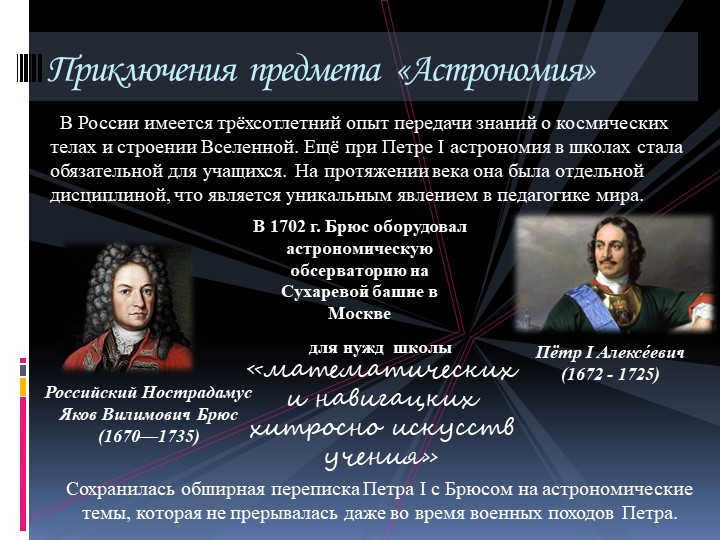
2 slide Russia has a wealth of knowledge and experience in the field of cosmic bodies and the structure of the Universe that spans over three hundred years. As early as Peter the Great’s era, the teaching of astronomy became mandatory in schools, making it a unique subject in the world of education.
The Fascinating Journey of “Astronomy”
We have preserved extensive correspondence between Peter the Great and Bruce on various astronomical topics, even during times of military campaigns.
A Visionary in Russia
Yakov Vilimovich Bruce
(1670—1735)
Peter I Alekseevich
(1672 – 1725)
In 1702, Bruce established an astronomical observatory on the Sukharev Tower in Moscow, specifically for the purpose of enriching the curriculum in the fields of mathematics and navigation.
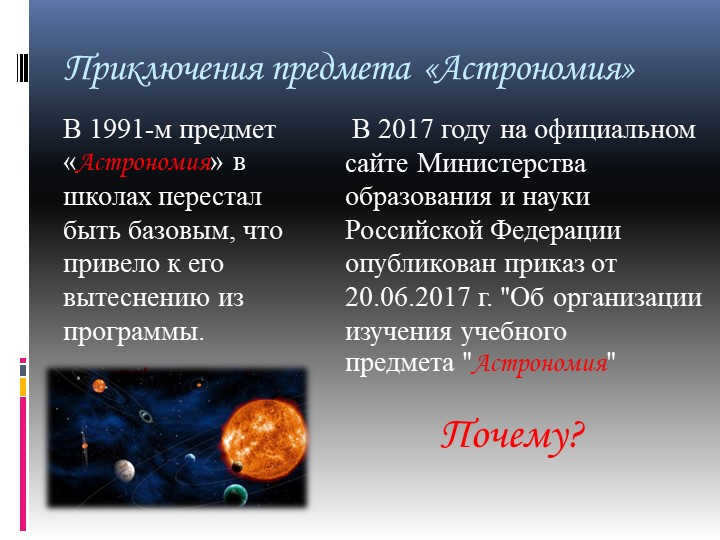
Slide 3 The Journey of the subject “Astronomy”
In 1991, the subject “Astronomy” was removed as a core subject in schools, resulting in its exclusion from the curriculum.
Why did this happen?
In 2017, the Ministry of Education and Science of the Russian Federation issued an order on 20.06.2017 regarding the organization of the study of the subject “Astronomy”.
What prompted this decision?
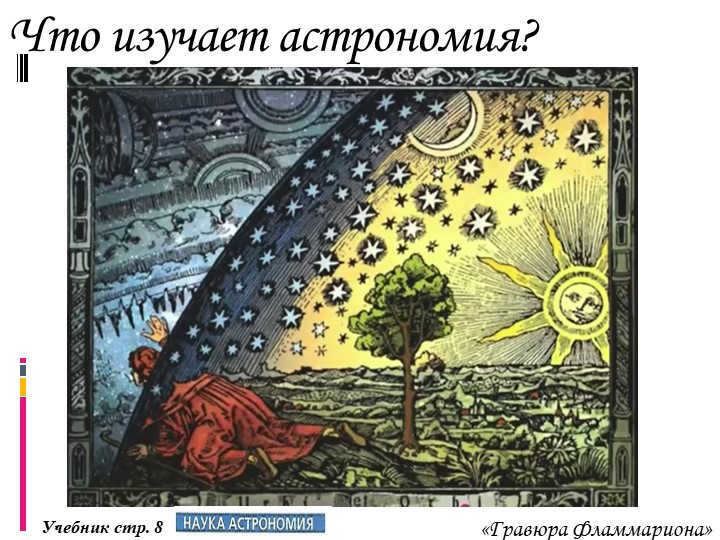
Slide 5: Astronomy is the field of study that focuses on the vastness of the cosmos.
Astronomy is a scientific discipline that explores the celestial objects and systems, as well as the phenomena that occur in space. It investigates the origins, existence, and evolution of these entities.
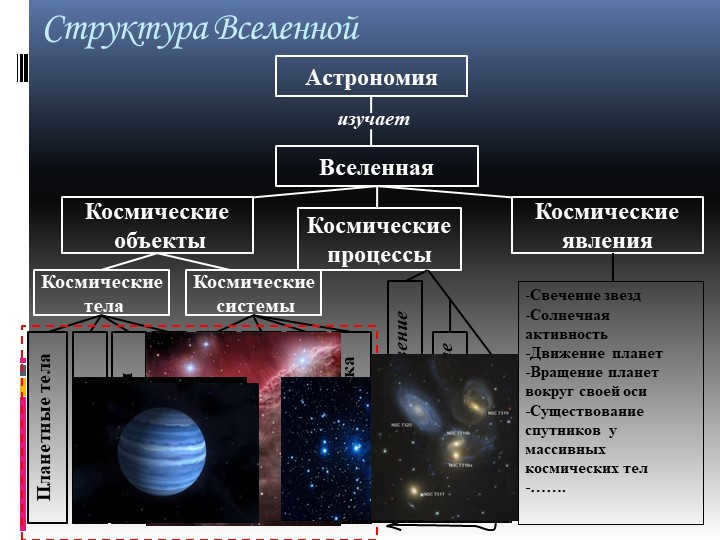
Slide 6: Understanding the Structure of the Universe
Astronomy
explores
the vast expanse of the Universe
its cosmic objects
cosmic processes
cosmic phenomena
the celestial bodies that inhabit it
the intricate cosmic systems that exist
the planets and other planetary bodies that orbit around stars
the formation and evolution of stars
the nebulae that give birth to new celestial bodies
the environment of outer space
the planetary systems that exist beyond our own
the stellar systems that house countless stars
the galaxies that form the building blocks of the Universe
the metagalaxy that encompasses all known galaxies
the emergence and existence of the Universe
the ongoing development and evolution of celestial bodies
the radiant energy emitted by stars
the activity of our own Sun
the motion of planets in their respective orbits
the rotational movement of planets on their own axis
the presence of satellites orbiting massive celestial bodies
…….

The structure of the Universe consists of 7 slides.
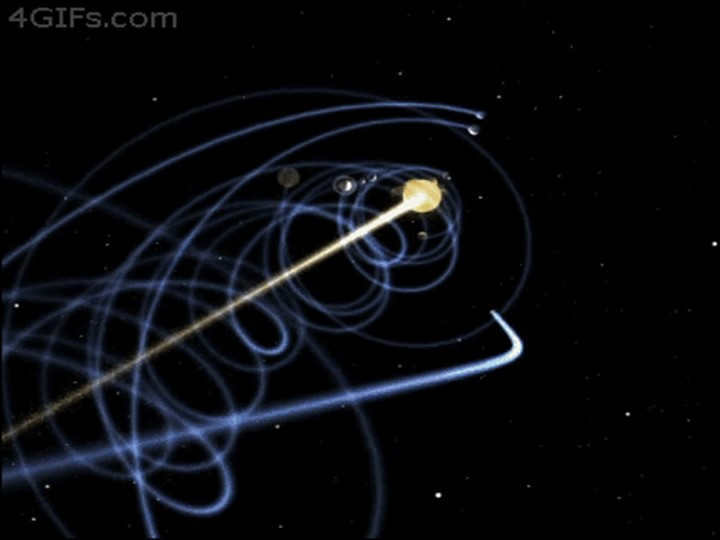
Slide 9: Exploring the Southern Region of the Milky Way
Unveiling the Complexity of the Universe
The Milky Way Galaxy: A Fascinating Stellar Ensemble
Our Galaxy boasts an impressive collection of several hundred billion stars.
It takes light, traveling at a speed of 300,000 km/s, more than four years to journey from the nearest star to our solar system and reach Earth.
Intriguingly, light can traverse the vast expanse of the Milky Way in a mere 100,000 years.
Sources: Chromoscope
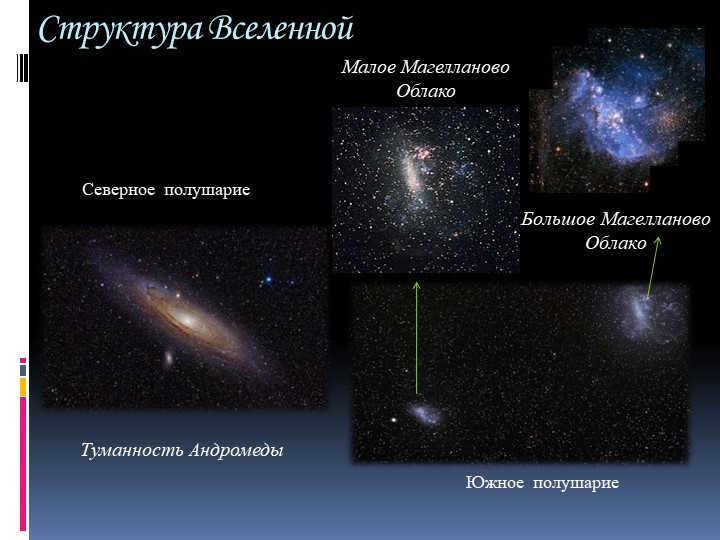

On slide number 10, we can observe the Large Magellanic Cloud, which is a fascinating celestial object. It is situated in the Southern Hemisphere and is a part of the Structure of the Universe. Another interesting nebula that can be seen in the image is the Andromeda Nebula, which is located in the Northern Hemisphere. Finally, we can also observe the Small Magellanic Cloud, which is another prominent feature in the vastness of space.
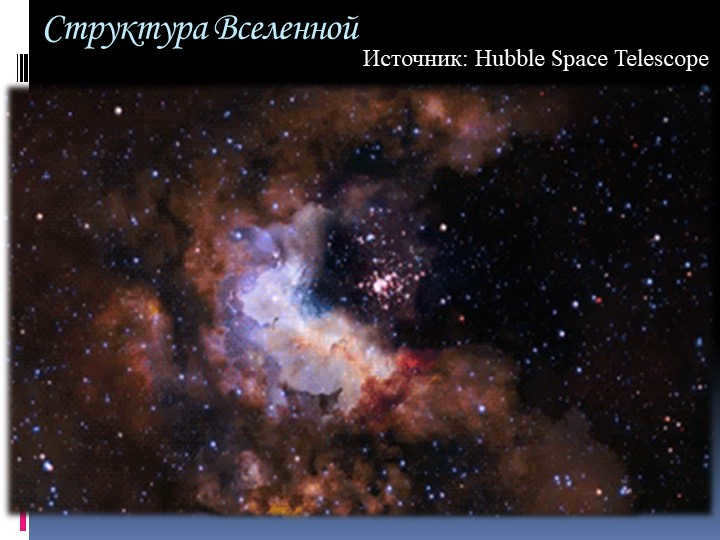
12 slide Scale of the Universe
Model of the Moon – a sphere measuring 7 cm in diameter placed at a distance of 7.5 m
Model of the Sun – a sphere measuring 28 m in diameter placed at a distance of 3 km
Model of Neptune – a sphere placed at a distance of 90 km.
Model of the closest star – a sphere placed at a distance of 800,000 km
A school globe representing the Earth
50 million times smaller
than our planet.
Earth globe
Source: Roscosmos
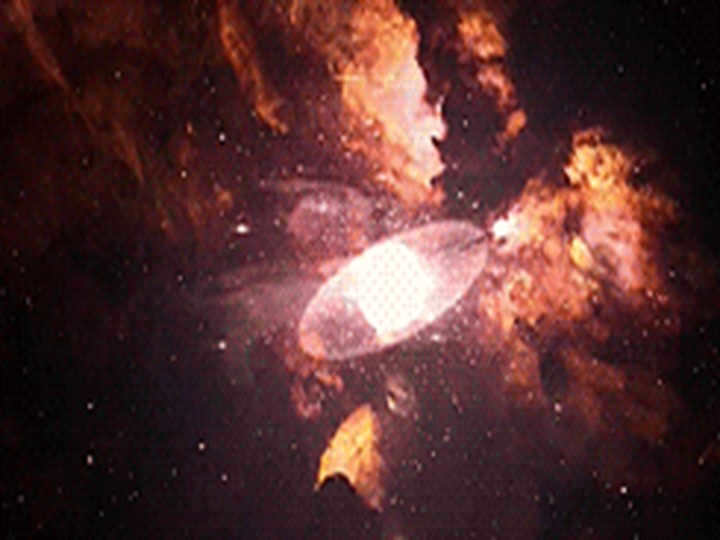

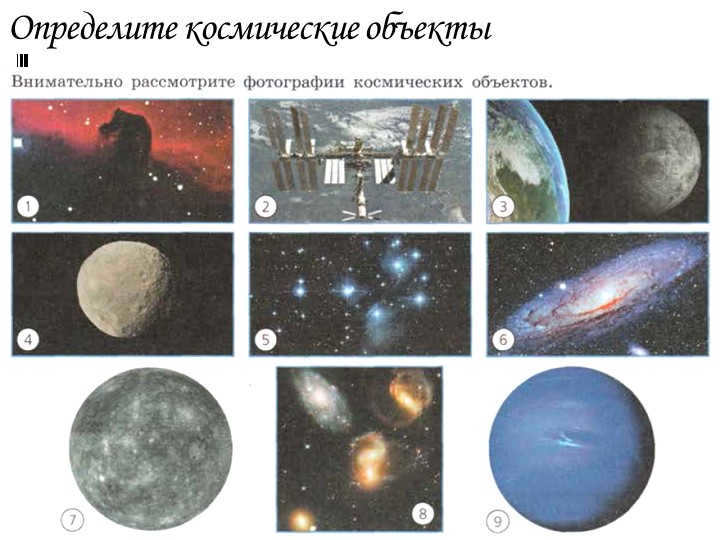

Slide 16 D/Hobbies:
1. Read section 1 and 2 of the textbook
2. Complete the table
3. Analyze the definition
4. Create a story, drawing, table, and block diagram on the topic “Structure and Scale of the Universe. Methods of study.”

For homework, please complete the following tasks:
1. Read section 1 and 2 of the textbook.
2. Fill in the table.

Slide 18 D/HO:
1. Read sections 1 and 2 of the textbook
2. Complete the table
3. Analyze the definition
Using explanatory dictionaries and reference books on the Russian language, analyze the definition word by word (in a column):
“Astronomy is the science of the universe, studying space objects and systems, space processes and space phenomena, their origin, existence, and development.”
– The word “science” is a noun.
– The word “of” is a preposition.
– etc.
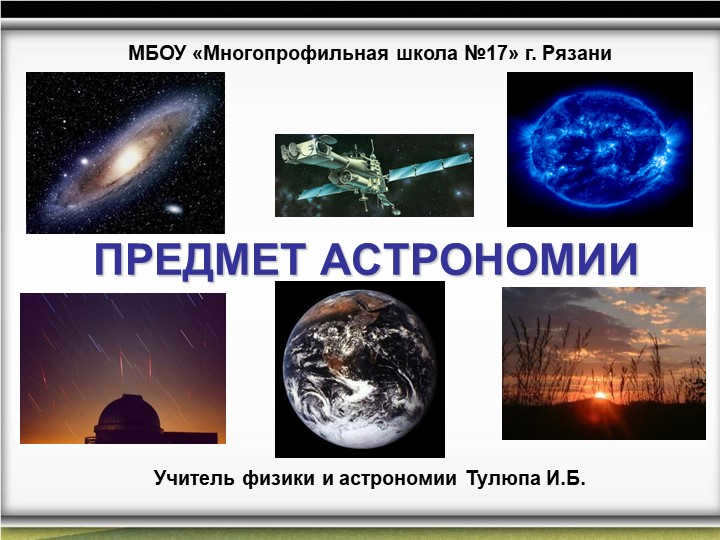
Currently, there are extra cumulative discounts (ranging from 2% to 25%) that can be availed by 58,741 educational establishments. To determine the applicable discount for all staff members of your educational institution, kindly sign in to your personal Infoworks account.


Professional development program
Implementing project-based research in literature courses under the FSES curriculum
We can apply a discount to your educational institution based on the number of colleagues who have taken Infowork courses.
Currently, there are 58,741 eligible educational institutions that can receive additional cumulative discounts ranging from 2% to 25%. To find out the specific discount applicable to all employees of your institution, please log in to your personal Infoworks account.


A course for professional development is available.
Discover new teaching methods and technologies for elementary school based on FSES guidelines.
We can apply a discount from your educational institution to this offer (the amount depends on how many of your colleagues have already completed Infowork courses).
Currently, 58,741 educational institutions are benefiting from additional discounts (ranging from 2% to 25%). To find out the available discount for all employees of your educational institution, please log in to your personal Infoworks account.


Organizing the responsibilities of educators: managing your actions effectively
Breakdown of the presentation by individual slides:

Preparation of Astronomy at MBOU “Multidisciplinary School № 17” in the city of Ryazan is conducted by Tuljupa I.B., a teacher of Physics and Astronomy.

For the second slide of our homework assignment, we are required to learn sections 1 and 2. Additionally, we need to understand the concept of summarizing information. Finally, we should bring a map of the starry sky and an overhead circle to use with the map.


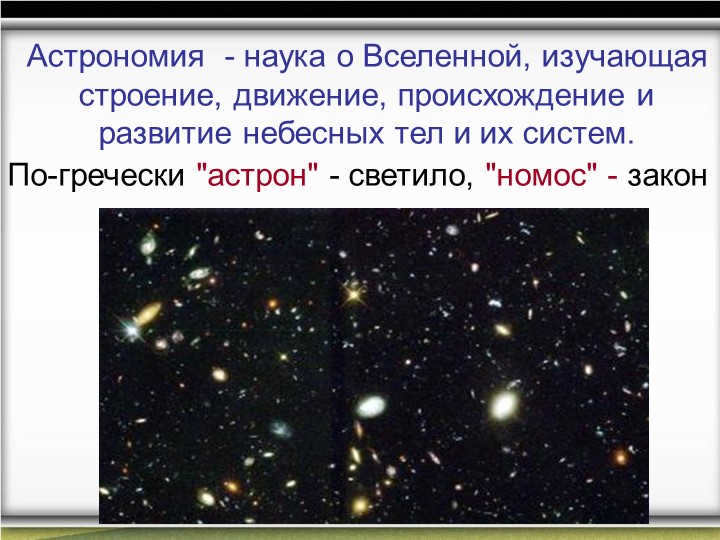
Astronomy, the fourth slide, is the scientific field that explores the composition, movement, creation, and growth of celestial objects and their systems. In Greek, the word “astron” means luminary, and “nomos” means law.

There are 5 slide Objects that are studied in the field of astronomy. These include Cosmic bodies, Planetary bodies, Cosmic objects and stages of formation, Star-like objects, Stars, and Cosmic Environment. Nebulae and Black holes are also important aspects of the cosmic environment.

Slide 6 Items studied in the field of astronomy include:
Cosmic systems
Satellites orbiting planets
Planetary Systems (such as the Solar System)
Star systems
Galaxies (including our own Galaxy)
Groups of galaxies
Galaxy clusters
Super clusters
Metagalaxy
Universe

Slide 7: Areas of focus in astronomy
Cosmic phenomena
The beginning and evolution of the Universe
The emergence and advancement of life and intelligence in the cosmos
The emergence, existence, and development of celestial objects and systems

The 8th slide discusses the subjects that are studied in the field of astronomy. These include various cosmic phenomena, such as the luminescence of stars (for example, the Sun). Additionally, the motion of cosmic bodies, such as the rotation of planets and satellites of planets, is also studied. Another area of focus is the existence of atmospheres, particularly near the Earth, the Sun, and other stars.

There are 9 objects of study in astronomy. These objects include various celestial phenomena.
Some examples of celestial phenomena that astronomers study are the visible motion of planets and the Sun, the change of seasons, and the change of phases of the Moon.
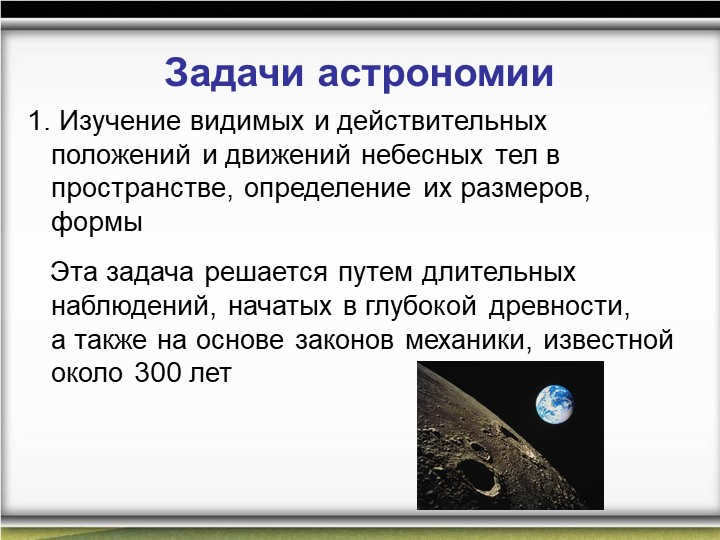

Slide 10: Aims of astronomy
Investigation into the observable and actual locations as well as movements of celestial objects in outer space, with the aim of determining their dimensions and forms.
This objective is accomplished through extensive observations, which have been conducted since ancient times, along with the application of the principles of mechanics that have been known for approximately 300 years.
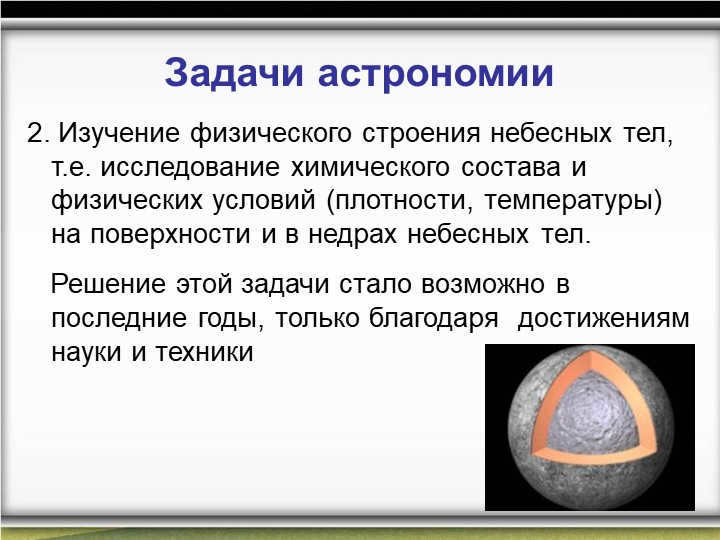
Slide 11: Objectives of astronomy
2- The examination of the physical makeup of celestial objects, specifically the investigation of their chemical composition and physical conditions (density, temperature) both on their surface and within their interiors.
In recent years, the solution to this task has become possible only due to the advancements in science and technology.
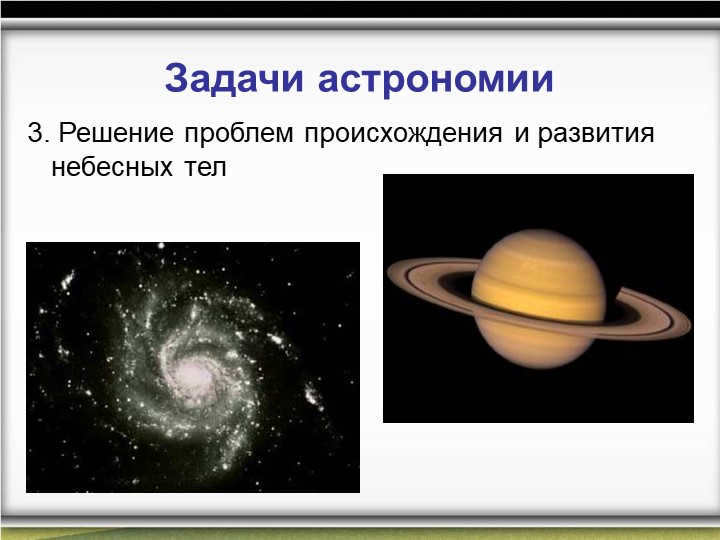
Slide 13 Astronomy is considered the oldest field of study.
Antiquity’s megaliths, such as Stonehenge, served as ancient observatories.
In Delhi, there is a solar observatory that dates back to ancient times.
Thousands of years ago, people were already making systematic astronomical observations.
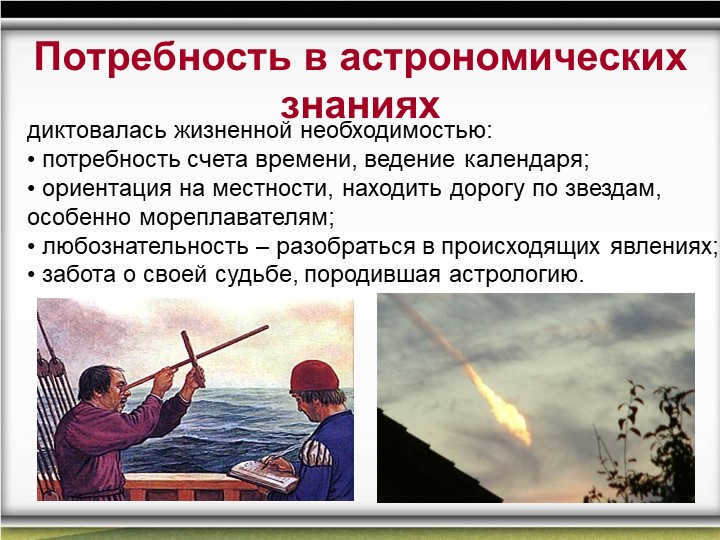
Slide 14 – The necessity for astronomical understanding
arose from practical needs:
the need to measure time and maintain a calendar;
to navigate using the stars, particularly for sailors;
a curiosity to comprehend natural phenomena;
and an interest in astrology to explore one’s destiny.
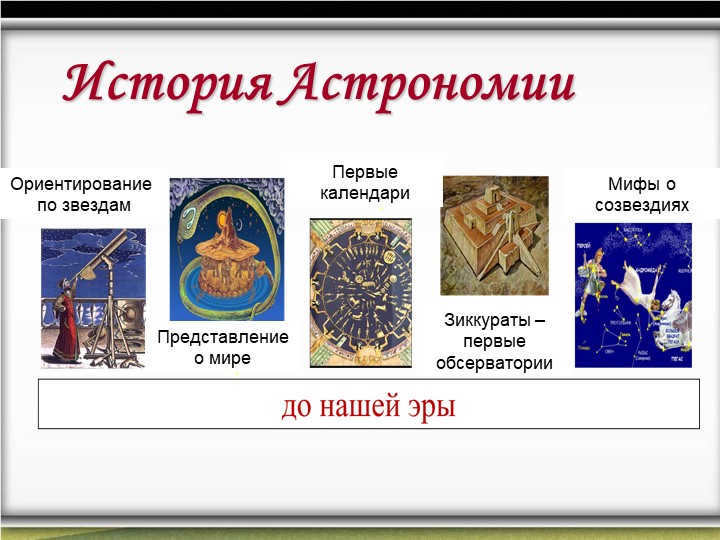
Slide 15: The Evolution of Astronomy
Stargazing
Guided by the Stars
Unveiling the Universe
The Earliest Calendars
Ziggurats: Pioneering Observatories
Legends Surrounding Constellations
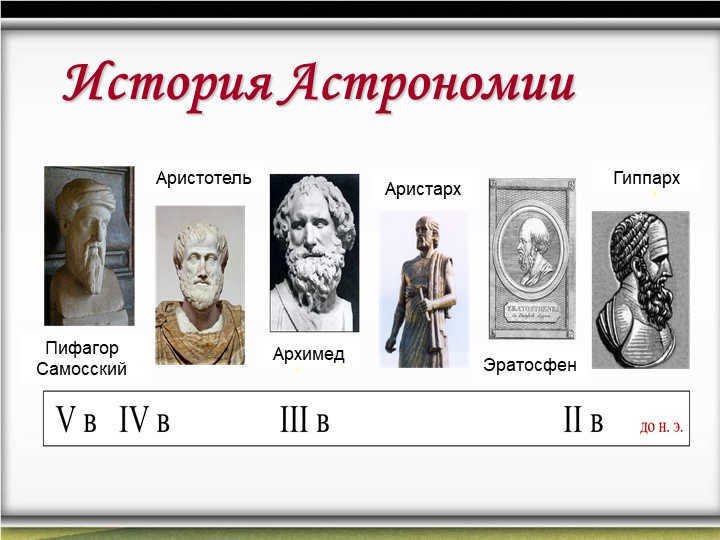
17 slide Timeline of Astronomy
Claudius Ptolemy
Giordano Bruno
Nicolaus Copernicus
Tycho Brahe
Johannes Kepler
Galileo Galigaeus
Isaac Newton
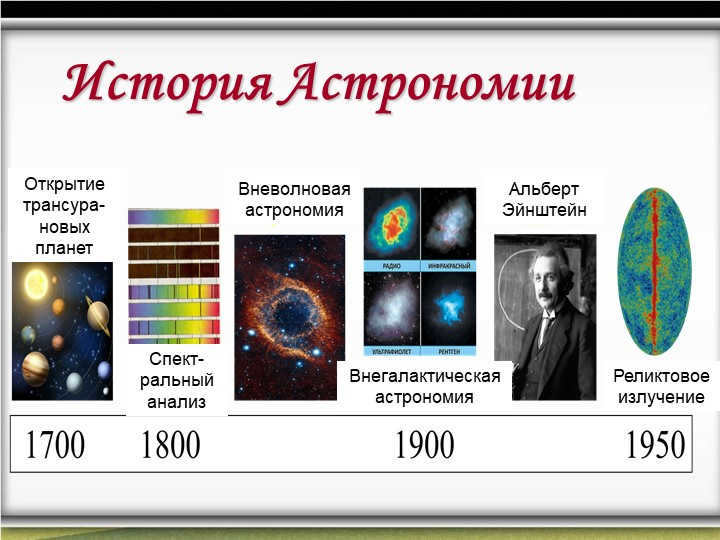
A unique version of the text with HTML markup:
18-slide Timeline of Astronomical Discoveries
unearthing
beyond-uranium
celestial bodies
Analysis of Spectra
Observing beyond the visible spectrum
Studying galaxies outside our own
Renowned physicist Albert Einstein
Fossilized radiation from the early universe
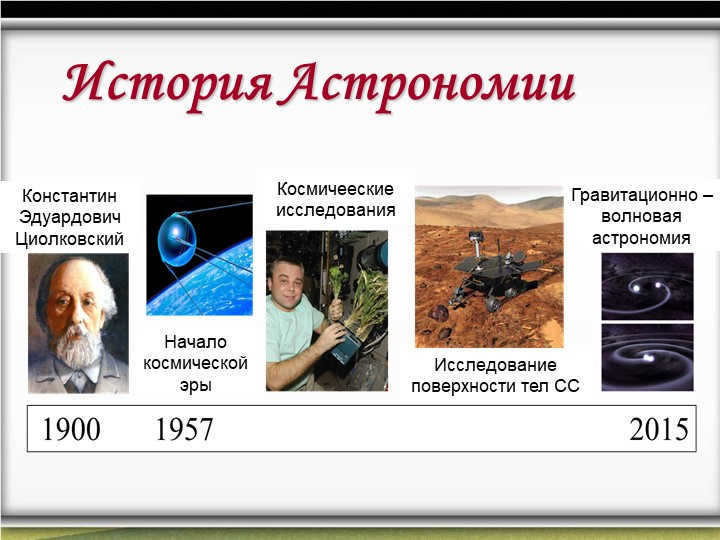

Slide 19: A Brief Overview of the History of Astronomy
Exploring the Cosmos: Konstantin Eduardovich Tsiolkovsky’s Contributions to the Space Age
The Dawn of a New Era: Space Exploration and its Implications
Unraveling the Mysteries: The Significance of Space Research
Understanding the Surface of Celestial Bodies: A Journey into Space
Unlocking the Secrets of the Universe: The Fascinating Field of Gravitational-Wave Astronomy


There are 20 sections in the field of astronomy. The first section is astrometry, which focuses on the measurement of space and time. Astrometry involves studying the position, apparent and true motion of celestial luminaries by creating star maps and catalogs. It also deals with determining fundamental astronomical constants and solving problems related to measuring and counting time, as well as calculating and compiling calendars. Additionally, astrometry provides geographical and topographical maps, and its methods of orientation are widely used in navigation, aviation, and astronautics.

21 slide Sections of astronomy
2. The study of celestial mechanics involves examining the movement of celestial objects in response to gravitational forces, while also considering the effects of radiation pressure, atmospheric resistance, changes in mass, and other factors.
By analyzing astrometry data and applying the principles of classical physics, scientists are able to calculate the trajectories and characteristics of motion for celestial bodies and their systems.
Celestial mechanics serves as the foundational theory for astronautics.

There are 22 slide sections dedicated to the study of astronomy.
3 Astrophysics is concerned with the examination of the fundamental physical attributes and properties of celestial objects, as well as the processes and phenomena that occur in space.
It can be categorized into various sections, including theoretical and practical astrophysics, planetary physics (planetology and planetography), solar physics, stellar physics, and extragalactic astrophysics, among others.

23 slide Sections of astronomy
4. The study of cosmogony focuses on the inception and progression of celestial bodies and their systems.
5. Cosmology investigates the fundamental patterns of the genesis, composition, and evolution of the Universe. Its foundation relies on contemporary physical theories, astrophysics data, and extragalactic astronomy.

Slide 24: The Universe encompasses the vast expanse of space where all celestial bodies and their systems exist for scientific exploration.
What is the total count of stars within the observable section of the universe? (page 8)
Universe
During a moonless night, how many stars become visible to the naked eye in both the Northern and Southern Hemispheres? –
using a school telescope? –
using a high-powered telescope? –
Approximately 4,000 to 6,000 stars.
Around 20,000 to 25,000 stars.
A staggering 10 billion stars.
An estimation of about 10 to the power of 22 stars.
The density of matter in the Universe measures 2.4 x 10 to the power of -26 kg/m3.
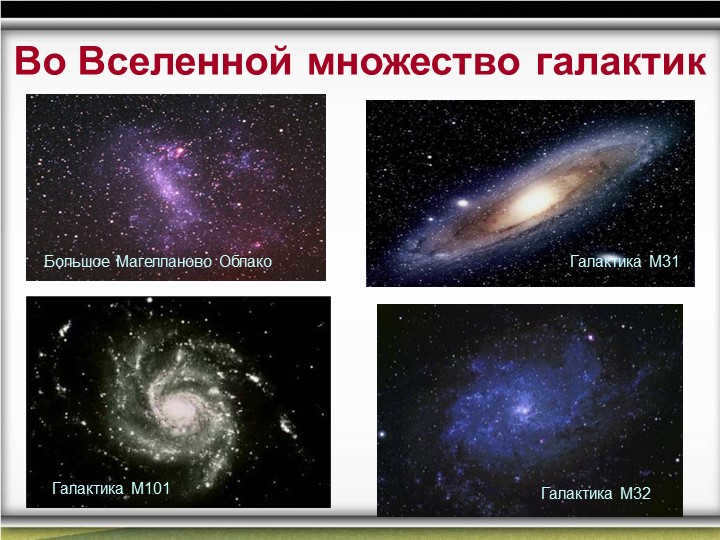

Slide 25: The Universe is teeming with countless galaxies, such as the celestial wonders of the Big Magellanic Cloud, the magnificent Galaxy M31, the enigmatic Galaxy M32, and the captivating Galaxy M101.
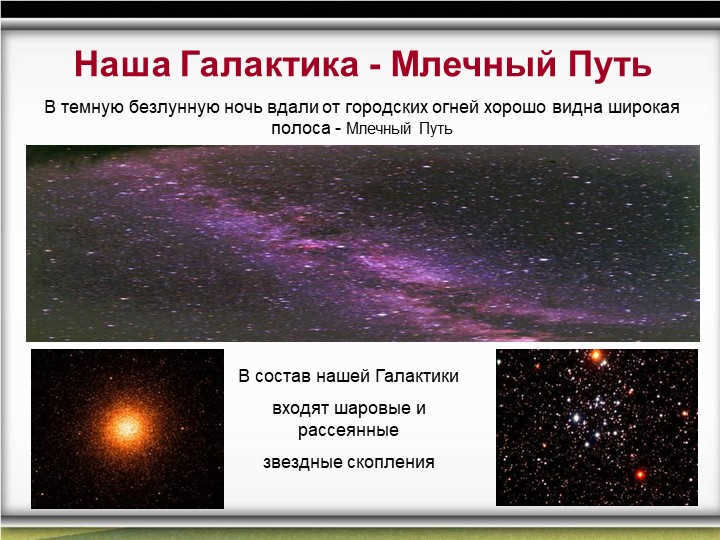
Slide 26: The Milky Way is our galaxy. When you find yourself in a remote area devoid of city lights on a moonless night, you can easily see a broad strip called the Milky Way.
Our Galaxy consists of various components, such as globular and dispersed star clusters.
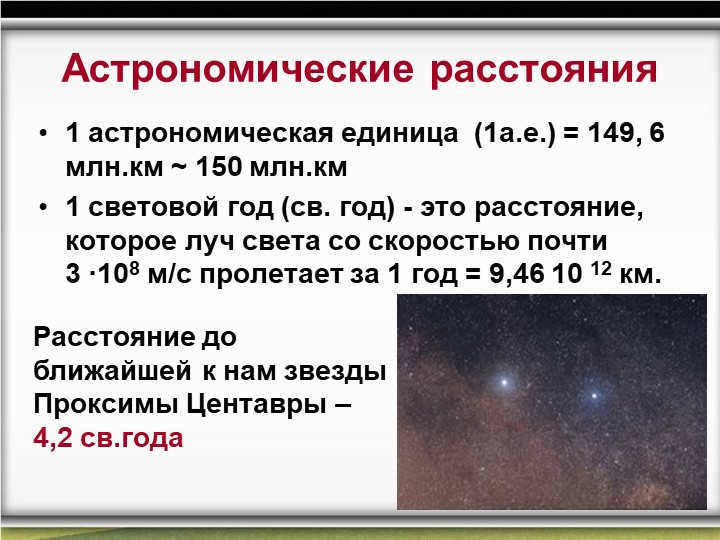
Slide 27 Astronomical distances
1 astronomical unit (1a.u.) is equivalent to approximately 150 million kilometers.
1 light year (sv.yr.) is defined as the distance traveled by a beam of light moving at a speed of nearly 3 -108 m/s in the span of 1 year, which is equal to about 9.46 10 12 km.
The distance to Proxima Centauri, the closest star to our solar system, is approximately 4.2 light years.
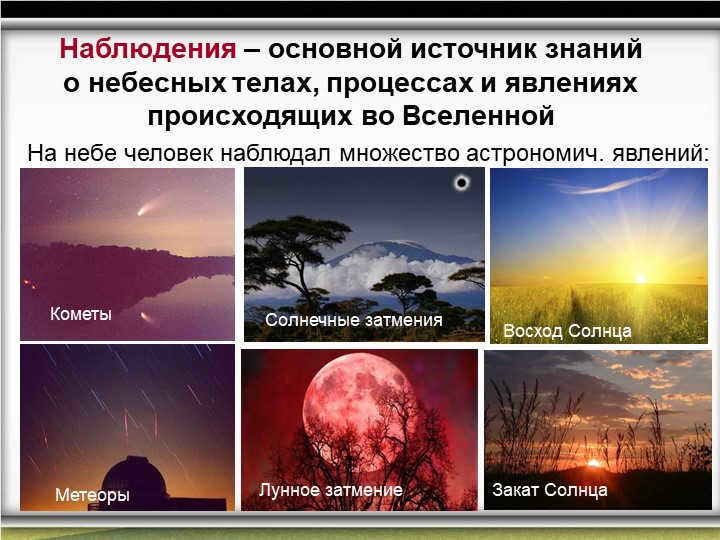
Slide number 28 is dedicated to the topic of solar eclipses, sunsets, meteors, and comets. Observations play a crucial role in expanding our knowledge about celestial bodies and the various processes and phenomena that occur in the vast expanse of the universe. Throughout history, humans have witnessed and documented numerous astronomical events in the sky, including lunar eclipses and sunrises.

There are various scientific research institutions that are dedicated to the study of the cosmos, known as astronomical observatories. These institutions play a vital role in conducting astronomical observations and advancing our understanding of the universe.
Some of the most well-known astronomical observatories in our country include the Main Astronomical Observatory of the Russian Academy of Sciences (RAS) located in Pulkovo, St. Petersburg, the Special Astrophysical Observatory of the Russian Academy of Sciences in the North Caucasus, and the State Astronomical Institute named after P.K. Shtenberg in St. Petersburg. Additionally, there is the P.K.Shtenberg State Astronomical Institute of the Moscow State University in Moscow.
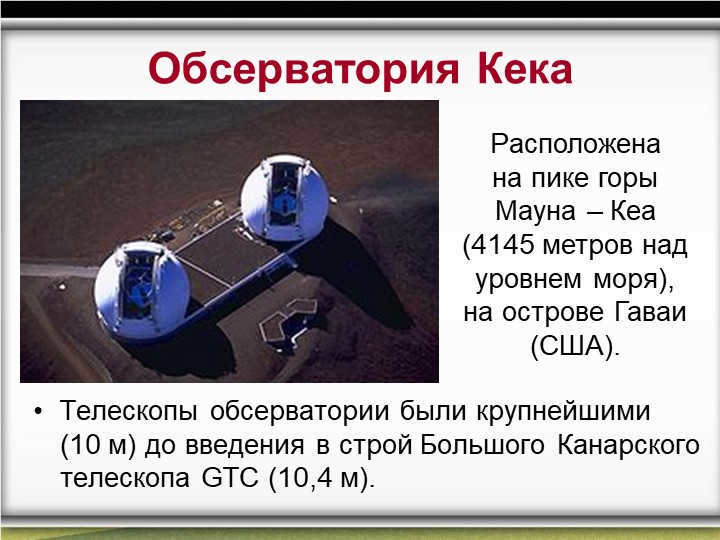
The Keck Observatory, with its 30 slides, had the largest telescopes (10 m) until the Great Canary Telescope GTC (10.4 m) became operational. It is situated atop Mount Mauna Kea (4145 meters above sea level) on the island of Hawaii in the United States of America.
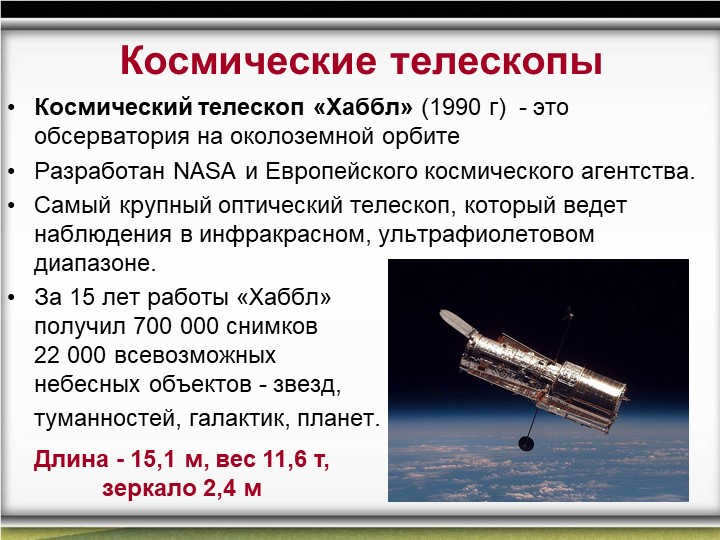

Slide 31 – Space telescopes
The Hubble Space Telescope (1990) serves as an observatory in Earth’s orbit.
It was developed jointly by NASA and the European Space Agency.
Being the largest optical telescope, it is capable of observing in the infrared and ultraviolet spectrums.
Over its 15-year operational period, Hubble has captured 700,000 images of 22,000 celestial objects, including stars, nebulae, galaxies, and planets.
It measures 15.1 meters in length, weighs 11.6 tons, and features a 2.4-meter mirror.
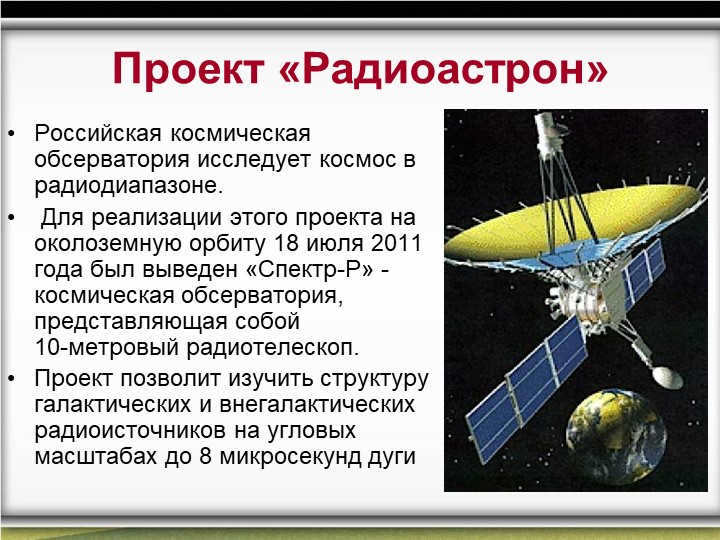
Radioastron Project in 32 slides
In the realm of radio waves, the Russian Space Observatory embarks on a mission to explore the vast cosmos.
In order to bring this ambitious project to life, Spektr-R, a 10-meter radio telescope, was launched into Earth’s orbit on July 18, 2011.
This initiative will pave the way for a comprehensive study of the structure of both galactic and extragalactic radio sources, with the capability to explore angular scales of up to 8 microseconds of arc.
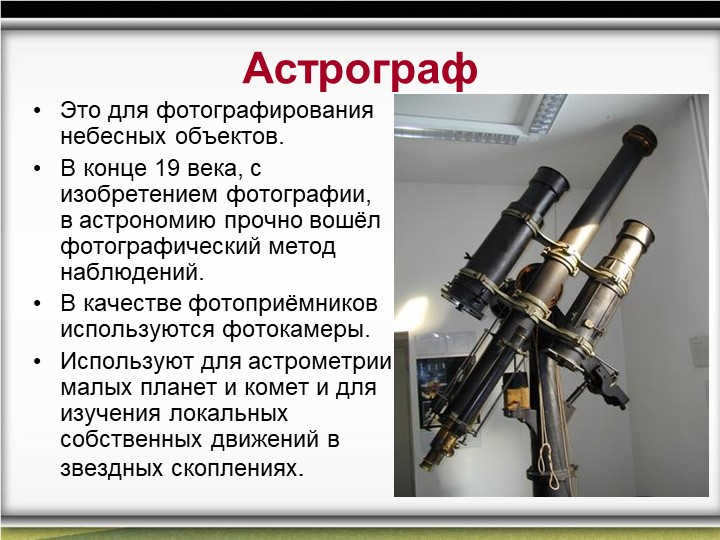
The 33-slide Astrograph is designed specifically for capturing images of celestial objects. It was developed in the late 19th century, following the invention of photography, and quickly became an essential tool in the field of astronomy.
Astrographs utilize photographic cameras as photodetectors, allowing for precise astrometry of small planets and comets. They are also used to study local proper motions in star clusters.
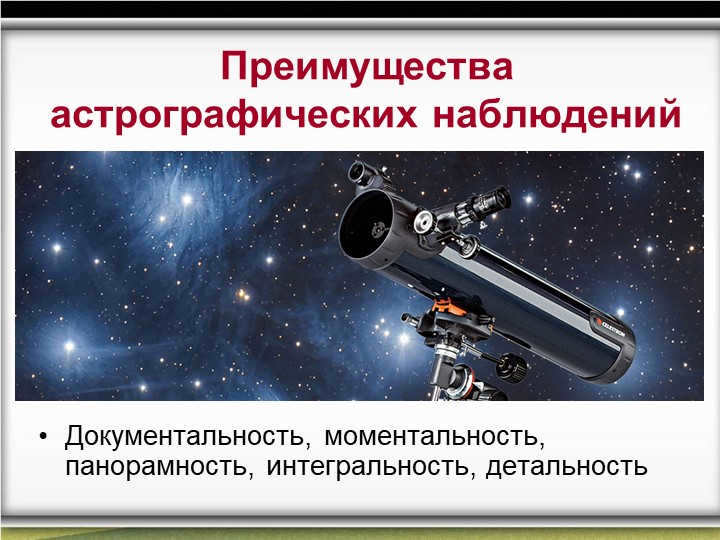
There are several advantages of astrographic observations, including their documentary, instantaneous, panoramic, integral, and detailed nature.


36 slide The relationship between astronomy and other sciences is significant. It has connections to various disciplines such as biology, geography, and literature.
In biology, astronomy plays a role in the study of hypotheses regarding the origin of life. It also contributes to understanding the adaptability and evolution of living organisms. Additionally, astronomy investigates the pollution of the surrounding space by matter and radiation.
In geography, astronomy helps to explain various natural phenomena. For example, it provides insights into the nature of clouds on the Earth and other planets. It also helps to understand tides in the ocean, atmosphere, and solid crust of the Earth. Furthermore, astronomy explains the evaporation of water from the surface of the oceans under the influence of the Sun’s radiation. It also sheds light on the uneven heating of different parts of the Earth’s surface by the Sun, which creates circulation of atmospheric flows.
In literature, astronomy has influenced ancient myths and legends, which are considered literary works. It has also been a source of inspiration for science fiction literature.

- Proof of the portfolio
- Unlimited access for only 99 rubles
- Over 3,800 video lectures available to all
The term astronomy is derived from the Greek language (astron – star, nomos – law), signifying a scientific discipline focused on the examination of celestial laws. Presently, it is widely recognized that the Universe encompasses a myriad of cosmic entities and their complexes, including planets, asteroids, comets, galaxies, and nebulae, in addition to stars (Fig. 1.1). Consequently, astronomers diligently investigate all non-Earthly objects and their interconnections. The Greek term cosmos denotes order, in contrast to chaos, which denotes disorder. Hence, ancient Greek scholars comprehended the existence of universal laws and an inherent order in the celestial realm. In contemporary times, the word cosmos typically refers to the entirety of the universe. Modern astronomy employs a diverse range of approaches to examine the cosmos. Astronomers not only acquire knowledge about remote worlds by analyzing the radiation reaching the Earth’s surface from space, but also conduct experiments in nearby and distant regions of space.
Throughout history, the sky has captivated the human imagination with its enigmatic nature. For centuries, it remained out of reach, shrouded in a sense of reverence. The human mind populated the heavens with gods who held dominion over the world, shaping the destiny of every individual. At night, the ethereal radiance of the stars held people spellbound, leading ancient astronomers to connect individual stars, forming constellations depicting humans and animals. This gave birth to the names of these celestial groups. Soon after, celestial bodies that traversed among the stars were observed, earning the name “planets” derived from the Greek word for wandering.
The earliest attempts to unravel the mysteries of celestial phenomena were made over 4000 years ago in ancient Egypt and in ancient Greece prior to the advent of our era. Egyptian priests crafted the first star maps and bestowed names upon the planets.
In the 6th century BC, the brilliant philosopher and mathematician Pythagoras proposed the groundbreaking idea that the Earth is a spherical shape and exists in space, unsupported and without any inclination. In the 2nd century BC, the astronomer Hipparchus calculated the distance between the Earth and the Moon and made a remarkable discovery regarding the precession of the Earth’s axis of rotation.
In the 2nd century AD, the ancient Greek philosopher Claudius Ptolemy developed a geocentric model of the universe, positioning the Earth at its center. According to Ptolemy’s system, the Earth is surrounded by eight concentric spheres, which house the Moon, the Sun, and the five known planets of that time: Mercury, Venus, Mars, Jupiter, and Saturn.
Stars, located on the 8th sphere, are interconnected and rotate around the Earth as a single entity. In the 16th century, the Polish astronomer Nicolaus Copernicus introduced the heliocentric model of the universe, where the Sun is positioned at the center, and the Earth along with other planets orbit around it in circular paths.
Copernicus’s brilliance lay in his breakthrough discovery of the heliocentric model, which erased the boundary between the heavens and Earth, and proposed that the universe operates according to the same laws that govern both Earth and space.
In 1609, the Italian physicist Galileo Galilei became the first to observe celestial bodies using a telescope, discovering Jupiter’s satellites and observing the stars of the Milky Way.
The 18th century in the field of astronomy is closely associated with the renowned English scientist Isaac Newton, who famously uncovered the law of universal gravitation. Newton’s significant contribution lies in his demonstration of the universality of the gravitational force, meaning that the same force that causes an apple to fall to the Earth also attracts the Moon as it orbits our planet. This gravitational force governs the movement of stars and galaxies and has a profound impact on the evolution of the entire universe.
The 19th century marked a new era in the exploration of the cosmos, starting with the groundbreaking discovery by German physicist Joseph Fraunhofer in 1814. Fraunhofer identified absorption lines in the Sun’s spectrum, now known as Fraunhofer lines, and subsequently, similar lines were found in the spectra of other stars. Astronomers rely on these spectra to determine vital information such as the chemical composition, temperature, and even the velocity of celestial bodies.
In the 20th century, the groundbreaking work of renowned German physicist Albert Einstein led to the development of the general theory of relativity. This theory provided astronomers with a deeper understanding of the peculiar phenomenon known as the red shift of absorption lines in the spectra of distant galaxies, which was first observed by American astronomer Edwin Hubble in 1929. Hubble’s discovery confirmed that galaxies were moving apart from each other, and subsequent research by scientists led to the formulation of a comprehensive theory explaining the evolution of the universe from its inception to the present day. This marked the birth of a new scientific discipline known as cosmology.
On October 4, 1957, a new era in space exploration began with the launch of the world’s first artificial satellite by the Soviet Union. Ukrainian scientists played a significant role in the creation of this historic achievement. Today, there are numerous unmanned spacecraft orbiting the Earth and exploring not only our immediate surroundings, but also the other planets within our solar system.
Our location in space
We are situated on Earth, which is one of the many planets in our solar system. These planets orbit the Sun as they move through space. Most of the planets, with the exception of Venus and Mercury, have their own moons that revolve around them. Alongside the Sun and the planets’ satellites, the Solar System is also home to hundreds of thousands of asteroids, small planets, millions of cometary nuclei, and meteoric matter. In relation to the Sun, the planets are positioned in the following order: the closest is Mercury, followed by Venus, Earth, Mars, Jupiter, Saturn, Uranus, and Neptune.
Comparison of the sizes of the Sun and the planets in our solar system. The Earth has an average radius of 6370 kilometers.
Breakdown of the composition of our solar system:
- Sun (star) – 1
- Planets – 8
- Dwarf planets – 3
- Planetary satellites – over 150
- Comets over – 1000000
Thousands of small planets orbit the Sun behind Neptune, and they are barely illuminated by its rays.
Distances in outer space are so vast that measuring them in kilometers is impractical. Therefore, astronomers have adopted the units of measurement known as an astronomical unit and light-year.
Beyond the boundaries of our own solar system, at a distance surpassing 100,000 astronomical units, lies the domain in which the gravitational pull of other stars takes effect. With the unaided eye, one can perceive roughly 6000 celestial objects in the form of stars, which amalgamate to form 88 distinctive constellations. However, the actual number of stars present surpasses this count, yet the feeble illumination emitted by these remote celestial bodies makes them solely discernible through the utilization of telescopic instruments. Assemblages of stars, united by the relentless force of gravity, are designated as galaxies. The cosmos harbors billions of these galaxies, within which resides our very own Milky Way, also known as the Chumaci Shliach. When we gaze upon the night sky, we perceive this magnificent celestial structure as a shimmering streak of silver. The Milky Way, derived from the Greek term for “milky circle,” is an immense system, encompassing a staggering 400 billion stars that encircle its central core. These blazing stellar entities are arranged in the form of a disk, adorned with spiraling arms.
Among the naked eye visible galaxies, the Andromeda Nebula is particularly notable. This stellar system shares a similar size and shape with our own Milky Way Galaxy, and it takes 2.3 million years for its light to reach Earth, indicating its distance as 2.3 million light-years. Galaxies are organized into clusters, forming the cellular structure of the Universe. The most distant celestial objects that can still be observed through modern telescopes are quasars, located at a distance of 10 billion light-years from Earth.
An astronomical unit (a.u.) represents the average distance between Earth and the Sun.
A light-year is the distance that light travels in one year, traveling at a speed of 300,000 km/sec.
Other galaxies are stellar systems composed of billions of stars orbiting a central point.
If in the future inhabitants of Earth wish to communicate with other civilizations, they can specify their space address as follows: planet Earth, Solar System, Milky Way Galaxy, Universe.
For those who are curious
The Universe contains approximately 10 billion registered galaxies. If each galaxy has an average of 1011 stars, then the total number of stars in the Universe is an astonishing 1021. This astronomical number, with 21 zeros, is difficult to comprehend, so the following comparison can provide some perspective. If we were to divide all the stars in the Universe by the number of people on Earth, each individual would possess one galaxy, which amounts to approximately 200 billion stars.
Astronomy’s Major Categories
Astronomy, a sprawling field of study, is intrinsically tied to scientific and technological advancements. It is segmented into distinct branches, each employing unique methods and tools for research.
Cosmology, a subdivision of astronomy, investigates the structure and evolution of the entire Universe. In the future, cosmology may amalgamate various natural sciences, such as physics, mathematics, chemistry, biology, and philosophy, to tackle fundamental questions regarding our existence:
- What are the origins of our world and why does it appear as we currently perceive it?
- How did life emerge on Earth, and is life present elsewhere in the cosmos?
- What does the future hold for our Universe?
Astrometry is the field of astronomy that examines the position and movement of celestial bodies and their systems.
Celestial mechanics is a branch of astronomy that investigates the laws of motion governing celestial bodies.
Astrophysics is a division of astronomy that explores the nature of cosmic bodies, including their structure, chemical composition, and physical properties.
Cosmology delves into the structure and evolution of the Universe as a whole.
For those who are inquisitive.
Conclusions
Astronomy is a field of study that explores various celestial bodies and their systems, as well as the interactions and processes that occur within them. Over the past millennium, our understanding of the Universe has undergone significant transformations – from Ptolemy’s geocentric model with crystalline spheres surrounding the Earth to our modern, awe-inspiring depiction of the vast cosmos. Astronomy is closely intertwined with other branches of natural science, including physics, chemistry, mathematics, biology, and philosophy, as the same fundamental laws govern both terrestrial and celestial phenomena. The Universe is in a constant state of change – stars and planets are born and explode, civilizations rise and fall. Yet, amidst this perpetual cosmic evolution, one question remains eternal: “Why does the Universe exist, and why are we fortunate enough to inhabit this enigmatic world?”.
Unique Tests
1. The sun.
2. Jupiter.
3. Saturn.
4. Earth.
5. Venus.
A. Mars.
B. Saturn.
C. Uranus.
D. Earth.
E. Jupiter.
A. Time.
B. Distance to the planets.
C. The period of revolution.
D. Distance to the stars.
E. Distance to the Earth.
A. The hairy star.
B. A tailed star.
C. The wandering star.
D. A nebula.
E. A cold body.
A. Elliptical.
B. Spiral.
C. Irregular.
D. Globular.
E. Cylindrical.
- What is the distinction between the geocentric and heliocentric systems of the world?
- In which order are the planets arranged in the solar system relative to the Sun?
- Is it possible for bodies to exist beyond the orbit of Neptune?
- What is measured in astronomical units?
- Find the magnitude (to the third decimal place) of 1 sv. year in kilometers.
- Determine the duration of time it takes for light to travel from the Sun to Earth, Neptune, and the edges of the solar system. Assume the speed of light is 300,000 km/s.
Discussion topics
Observational tasks
Important concepts and terms:
The field of astronomy is built upon various concepts such as the astronomical unit, astrophysics, the Galaxy, the heliocentric world system, the geocentric world system, stars, celestial mechanics, planets, and light years.
It is important to note that observation plays a crucial role in the study of astronomy.
Observation serves as the primary means of gathering information about celestial bodies, processes, and phenomena in the universe. Numerous countries have established specialized research institutions, known as astronomical observatories, to carry out these observations. Russia alone boasts several dozen observatories, including the renowned Main Astronomical Observatory of the Russian Academy of Sciences – Pulkovo Observatory (located in St. Petersburg) (see image above), the Special Astrophysical Observatory (situated in the North Caucasus) (see image), the State Astronomical Institute named after P. K. Sternberger (also in St. Petersburg) (see image), and the P. K. Sternberg State Astronomical Institute (based in Moscow), among others.
Contemporary observatories feature large-scale optical telescopes that are both sizable and intricate, incorporating advanced automation technologies.
In the field of astronomy, the measurement of the space between celestial objects is determined by the angle formed by the rays originating from the point of observation and extending to the objects. This measurement is referred to as angular distance and is denoted in degrees and fractions of a degree. By using the naked eye, it is feasible to discern two stars as distinct entities if they are positioned at a minimum separation of 1-2' in the sky. In the case of large telescopes, it becomes possible to observe stars individually, even when their angular distance is reduced to a hundredth or even a thousandth of a second (equivalent to an angle of 1'' “visible” from a matchbox located about 10 kilometers away).
Optical telescopes come in various forms. In refractor telescopes, which rely on light refraction, the rays from the sky are collected by a lens (or a series of lenses). Reflector telescopes, on the other hand, utilize a concave mirror to concentrate the reflected rays. Mirror-lens telescopes, also known as cadioptrics, employ a combination of mirrors and lenses (refer to the figure).
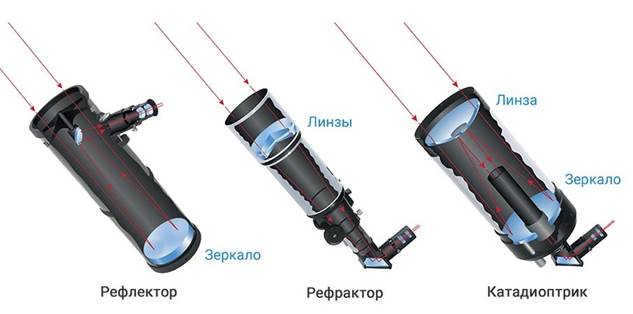
By 2024, the most advanced telescope in the world will be installed on the summit of the Chilean mountain Cerro Armazones at an altitude of 3060 meters (see Figure). With a mirror diameter of 39.3 meters, this telescope will surpass all currently existing instruments of its kind in terms of light collection. The mirror will be composed of 798 individual segments, enabling the telescope to gather 15 times more light than any other telescope currently in operation. In addition to its impressive light collection capabilities, this groundbreaking project will utilize state-of-the-art technologies to enhance image resolution and capture previously unexplored regions of the cosmos. In 2015, a ceremonial stone was laid at the observatory site, which required leveling the construction area by blasting the top of the cliff.
Astrographs are telescopes that are specifically designed for capturing celestial objects through photography. These telescopes have the capability to not only provide visual and photographic observations, but also high-precision photoelectric and spectral observations. The use of photography in astronomical observations offers several advantages compared to visual observations. These advantages include the ability to document and record phenomena and processes, preserving the acquired information for a significant period of time. Additionally, photography allows for the instantaneous capture of short-term phenomena that occur at a specific moment. Furthermore, astrographs have the ability to capture multiple objects and their relative positions on a single photographic plate, providing a panoramic view. Another advantage is the ability to accumulate light from faint sources, resulting in detailed images.
Information regarding temperature, chemical composition, magnetic fields, and celestial body movement is acquired through spectral observations. Understanding the fundamentals of spectral analysis, which will be taught in your physics course, is highly significant in the field of astronomy.
Celestial bodies not only emit light, but also release electromagnetic waves with longer wavelengths (infrared, radio waves) or shorter wavelengths (ultraviolet, X-rays, and gamma rays).
Various breakthroughs in solar system and galaxy research have been made using radio telescopes specifically designed for studying celestial bodies in the radio frequency range. One of the largest radio telescopes, known as RATAN-600, is situated at the Special Astrophysical Observatory. Its antenna consists of movable components (shields) positioned in a circular formation with a diameter of 600 meters. Additionally, a 6-meter reflector telescope is also present at this location.
In Puerto Rico, there is a reflector and radio telescope that operates at a relatively low altitude of 497 meters (see figure). This telescope has a mirror diameter of 304.8 meters and has been in operation since 1963. Since the early 90s, it has been utilized in the search for extraterrestrial civilizations.
Radio telescopes have the advantage of being easily networked. They can be located in various parts of the Earth or in close proximity to one another. By working together, these telescopes can form interferometers with a baseline spanning several thousand kilometers, or the equivalent of a mirror with a diameter of hundreds of meters. With such telescopes, it is possible to achieve a resolution that is comparable to, or even better than, that of optical telescopes.
The SKA radio interferometer is scheduled to be operational by 2020 and is expected to be 50 times more powerful than the current largest radio telescopes on Earth. Its array of antennas will span approximately 1 square kilometer, granting it unparalleled sensitivity.
The Earth’s atmosphere absorbs a significant amount of the invisible radiation emitted by celestial bodies, preventing it from reaching the surface. To compensate for this, ground-based observations need to be supplemented with extra-atmospheric observations facilitated by the launch of artificial Earth satellites, automatic interplanetary stations, and orbiting scientific stations. Onboard astronomical instruments on these satellites and stations allow for the study of celestial bodies across all wavelengths. Notable scientific achievements have been made with the help of both domestic and foreign orbital observatories such as Radioastron, Granat, and the Hubble Space Telescope. This shift towards all-wave astronomy has expanded the field of astronomy beyond just optical observations.
Astronomical observations continue to play a vital role in addressing significant issues in the national economy. These tasks encompass measuring time, creating precise geographical maps, conducting various geodetic operations, and navigating using celestial bodies both at sea and in outer space.
Nevertheless, the significance of astronomy extends beyond these applications. The study of the Moon and planets within our solar system enhances our understanding of Earth. The exploration of near-Earth space and neighboring celestial bodies is already becoming part of human activities. In the future, space exploration will enable the expansion of human habitats, which may facilitate the resolution of environmental challenges.





